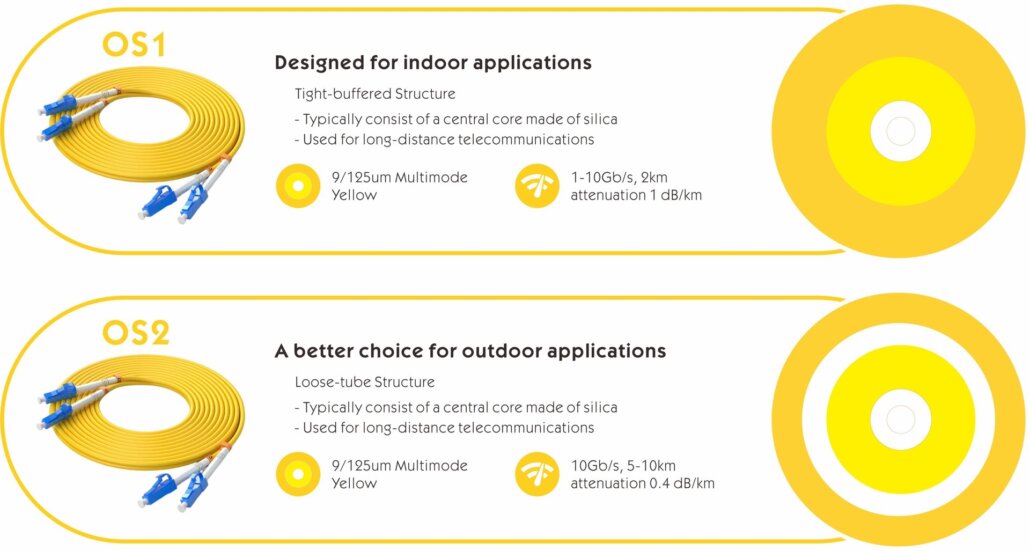The single-mode fiber includes OS1 and OS2. Then, what are the differences between OS1 and OS2? How to choose between them? This article holds the key to unraveling the differences and making the right choice between OS1 and OS2 fibers.
What is OS1 Fiber?
OS1 fiber generally refers to single-mode fiber that adheres to the ITU-T G.652A and ITU-T G.652B standards (conventional). Additionally, low water peak fibers falling under ITU-T G.652C and G.652D are also considered part of OS1. This tightly buffered fiber boasts a 1.0 dB/km attenuation, making it suitable for short-distance transmissions in indoor environments, typically up to 2 km under 10 Gigabit Ethernet. As an older legacy fiber, OS1 has lower performance requirements compared to OS2, making it easier and more cost-effective to manufacture.
What is OS2 Fiber?
OS2 fiber is single-mode low-water peak fiber, complying with ITU-T G.652C and ITU-T G.652D specifications. In practical applications, OS2 fiber often refers to G.652D, as G.652A and G.652B fibers have high attenuation characteristics unsuitable for 1383nm transmission. G.652D fiber overcomes this limitation, enabling full-spectrum transmission with low attenuation in this band.
The outstanding performance of OS2 fiber makes it ideal for full-band CWDM and DWDM applications, maximizing fiber utilization. With a maximum attenuation of 0.4dB/km, it excels in long-distance outdoor transmission, supporting network throughputs of up to 100 Gbit/s over distances of approximately 200 km. Its superior characteristics make OS2 fiber a powerful choice for high-performance and high-capacity fiber optic networks.
OS1 vs OS2 Fiber, What is the Difference?
Now, let’s take a quick look at the differences between single mode fibers. The comparison chart below simplifies the key distinctions.
| Comparison | OS1 | OS2 |
| ITU-T G.652 Standards | ITU-T G.652A/B/C/D | ITU-T G.652C/G.652D |
| Cable Construction | Tight Buffer | Loose Tube |
| Application | Indoor | Outdoor |
| Attenuation | 1.0dB/km | 0.4dB/km |
| Wavelength | 1310nm, 1550nm | 1310nm, 1383nm, 1550nm |
| Max. Distance | 10 km | 200 km |
| Price | Low | High |
- Cable Construction
OS1 fibers are commonly enclosed in a robust polymer jacket and are often utilized in cable constructions with tightly buffered interiors. This construction is well-suited for indoor applications, providing protection and durability.

On the other hand, OS2 fiber is best suited for loose tubes or blown fibers in cable constructions, making it particularly suitable for outdoor use. In this scenario, the fiber experiences minimal pressure, allowing the cable to be extended without stretching the fiber itself. This design ensures reliable performance and longevity in outdoor environments. - Attenuation
The attenuation in OS2 fiber is significantly lower than that in OS1. OS1 typically has a maximum attenuation of 1.0dB/km, while OS2 boasts a much lower 0.4dB/km. This disparity in attenuation translates to varying transmission distances.SMF Types OS1 OS1 OS2 OS2 G.652 Standards G.652.A G.652.B G.652.C G.652.D 1310nm ≤0.5 db/km ≤0.4 db/km – – 1310nm-1625nm – – ≤0.4 db/km ≤0.4 db/km 1383±3nm – – ≤0.4 db/km ≤0.4 db/km 1550nm ≤0.4 db/km ≤0.35 db/km ≤0.3 db/km ≤0.3 db/km 1625nm – ≤0.4 db/km – – (OS1 OS2 Attenuation Coefficient of Standard ITU-T G.652.A B C D)
S1 vs OS2 Fiber, How to Choose?
- Application
OS1 optical fiber cables are specifically designed for indoor network infrastructures, making them an excellent choice for internal building/campus networks, telecommunication exchanges, and data centers.
On the other hand, OS2 optical fiber cables are better suited for outdoor applications and universal loose tube solutions, including external plant and most backhaul networks. For outdoor network infrastructure needs, OS2 is the preferred option. - Distance
OS1 single mode fiber can achieve a maximum transmission distance of up to 10 km, while OS2 can cover an impressive 200 km—far surpassing OS1. This substantial advantage makes OS2 the preferred choice in practical fiber optic cabling, especially for long-distance applications where reliable and efficient data transmission is crucial. - Cost
The enhanced performance requirements of OS2 fiber, including lower attenuation and full wavelength support, increase manufacturing complexity, ultimately impacting the cost. As a result, OS2 fiber generally comes at a higher price point compared to OS1 fiber.
FAQ About OS1 vs OS2 Fiber
Q: Is OS2 fiber better than OS1?
A: Yes, in terms of performance, OS2 fiber is superior to OS1. However, OS1 fiber is more cost-effective and still suitable for certain short-distance applications.
Q: Are OS1 and OS2 interchangeable?
A: No, OS1 and OS2 fibers are not interchangeable. They have different features and parameters tailored for specific applications. Avoid mixing them unless used with a WDM multiplexer.
Q: Can OS1 fiber support 40G & 100G?
A: No, OS1 fiber cannot support 40G and 100G speeds. It has a maximum capacity of 10G.
Q: What is Polarization-mode dispersion?
A: Polarization-mode dispersion (PMD) is a dispersion effect in fiber optics, where light traveling in different polarization directions experiences varying phase speeds, leading to dispersion as the beam travels along the fiber.
Conclusion
Having read this post, are you now familiar with OS1 and OS2 fiber? Can you distinguish their differences and applications? If any information is missing, please let us know. As a professional fiber optic vendor, Bonelinks provides OS1 and OS2 single mode fiber cables, along with a wide range of multimode fiber cables. Rest assured, we offer optimal solutions for your needs.




